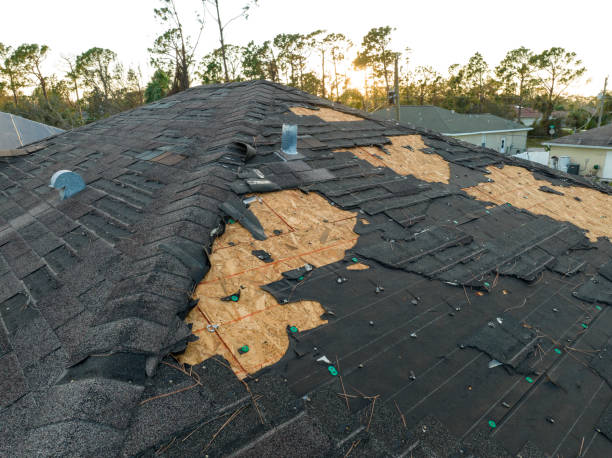Hailstorms can wreak havoc on your property, causing significant damage that may not be immediately visible. This guide will help you understand how hail damage in midland impacts your home or business, how to identify it, and what steps to take for repairs.
What is Hail Damage?
Hail damage occurs when ice pellets from a storm hit your property, causing dents, cracks, or other damage to materials like roofing, siding, windows, and vehicles. Hail can range from small, pea-sized pellets to large golf ball-sized chunks that cause severe damage, particularly to roofs and vehicles.
Common Areas Affected by Hail Damage
Several parts of your property are vulnerable during a hailstorm. Here are the most common areas to inspect after a storm:
- Roofing: Shingles can crack, granules may wear off, or, in severe cases, holes can form.
- Siding and Gutters: Dents, cracks, and chipping are common on siding and gutters.
- Windows: Hail can cause cracks or shatter glass windows.
- Vehicles: Cars left exposed during a hailstorm may develop dents or broken windows.
Signs of Hail Damage to Look For
Hail damage isn’t always immediately visible. Here are some signs to look for:
- Dents or cracks in shingles or siding
- Missing granules on asphalt shingles
- Visible water leaks in your attic after a storm
- Dings or cracks in windows and doors
- Water spots on ceilings, indicating roof leaks
How to Perform a Post-Hailstorm Inspection
After a hailstorm, inspecting your property is essential for identifying damage early. Here’s a step-by-step guide:
- Inspect the roof: Look for any visible dents, missing shingles, or granule loss.
- Check the siding and gutters: Walk around your property and look for any obvious dents, cracks, or chipping in siding, gutters, and downspouts.
- Look at the windows: Check for any cracks, chipped glass, or damaged frames.
- Inspect the attic: Check for signs of water leaks or damage to insulation.
Immediate Steps to Take After Hail Damage
Once you identify hail damage, you should take the following steps to protect your property:
- Take photos: Document the damage to provide to your insurance company.
- Make temporary repairs: If there are leaks or broken windows, cover them with tarps or boards to prevent further damage.
- Contact your insurance company: Report the damage and begin the claims process immediately.
- Hire a professional contractor: An experienced contractor can assess the damage and provide repair estimates.
Understanding Hail Damage and Insurance Claims
Insurance claims for hail damage can sometimes be complex, but most policies cover it as a natural event. Here’s how the process typically works:
- Documentation: Photos and reports from a contractor or roofing specialist will be necessary to file your claim.
- Assessment: An adjuster may be sent to assess the damage and determine how much coverage your policy offers.
- Repairs: Once approved, your insurance company will provide funds for repairs, less any deductible.
Professional Hail Damage Repair Services
It’s crucial to hire a professional contractor with experience in handling hail damage to ensure the repairs are done correctly. Here’s what to expect:
- Roof repair or replacement: Depending on the severity, you may need some shingles replaced or a full roof replacement.
- Siding and window repairs: Cracked or chipped siding will need to be repaired, and broken windows should be replaced immediately to prevent water damage.
- Gutter repair or replacement: Dented gutters can impact drainage, so replacing or repairing damaged sections is essential.
Preventing Future Hail Damage
While you can’t stop a hailstorm, you can take steps to reduce potential damage:
- Install impact-resistant shingles: These are designed to withstand hail damage better than traditional shingles.
- Use storm shutters: Installing shutters can protect your windows from breaking during hailstorms.
- Park vehicles under cover: Keep cars in a garage or under a carport to avoid hail damage.
The Importance of Regular Inspections and Maintenance
Regular property inspections can help you catch damage early and prevent costly repairs down the road. After a hailstorm, always check your property for any signs of damage, and contact a professional if you need repairs.
FAQs
1. How can I tell if my roof has hail damage?
Look for signs such as dents, missing shingles, or granules in your gutters. You may also notice water leaks in your attic, which indicates more severe damage.
2. Does insurance cover hail damage?
Most home insurance policies cover hail damage, but it’s essential to check the specifics of your policy. Always document the damage and file a claim as soon as possible.
3. Can I inspect the damage myself, or should I hire a professional?
You can perform a basic inspection yourself, but it’s advisable to hire a professional for a more thorough assessment, especially for roof damage.
4. How long do I have to file an insurance claim after a hailstorm?
Most insurance policies require you to file a claim within a specific time frame after the storm, typically between six months to a year. Check with your insurer for details.
5. How can I prevent hail damage in the future?
You can install impact-resistant roofing materials, use storm shutters for windows, and keep vehicles in a covered area during storms.
Summary
By understanding the effects of professional hail damage and taking proactive measures to inspect, repair, and maintain your property, you can minimize long-term issues and protect your home or business from future storms.




